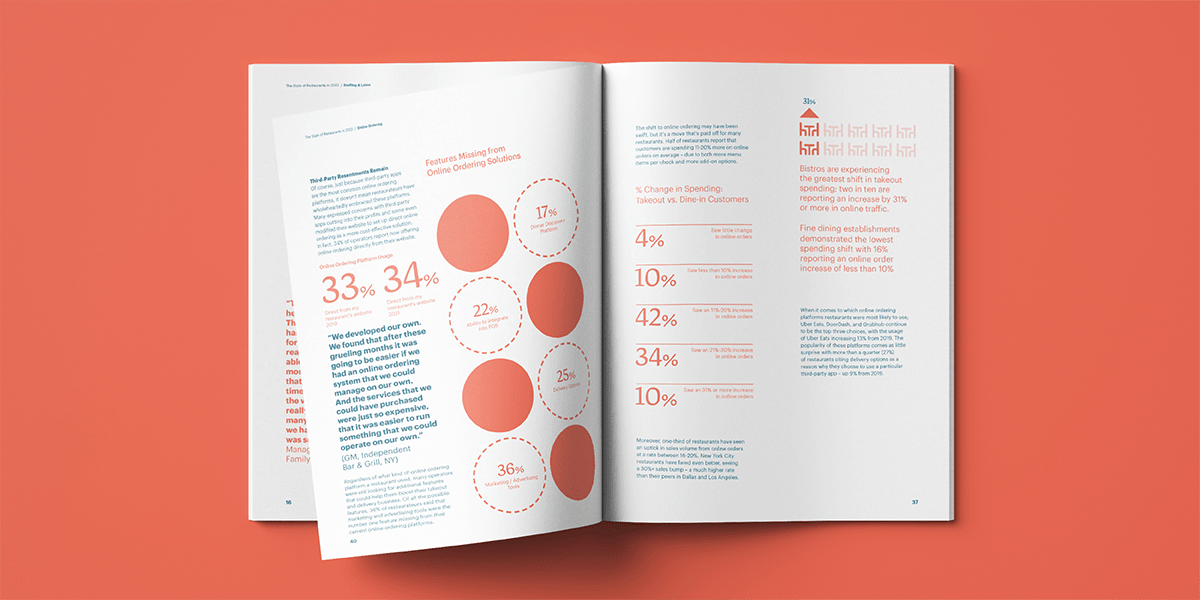
While the initial closure of full-service restaurants (FSRs) in early 2020 was a major financial blow to many operators, findings from the third annual State of Full Service Restaurants Report released today by TouchBistro reveal the financial health of FSRs across the U.S. is more complicated than a few months of lost revenue. The report finds that 74% of FSRs managed to maintain or increase their sales during the pandemic; however, profit margins in 2021 declined to 10%, compared to 12% in 2019(1). The research also includes city-specific reports for New York City, Los Angeles, and Dallas to provide insights on location-specific factors affecting restaurants. In addition, the report identifies five emerging trends in the U.S. restaurant industry that can help FSRs navigate these uncertain and challenging times.
Available for free download, the latest State of Full Service Restaurants Report finds increased inventory costs caused the greatest financial strain for operators in 2021 with 33% citing it as their top expense, followed closely by rent (30%) and labor (30%). Many operators also noted that the cost of implementing new health and safety measures – such as providing PPE for staff and upgrading their HVAC systems – was another major expense that wiped out any revenue gains in 2021.
“From social distancing measures to the rise of QR code menus, the way operators must now run restaurants has significantly changed since the onset of the pandemic,” says Samir Zabaneh, CEO of TouchBistro. “While our findings reveal just how much has changed since our 2020 report, they also show how resilient FSRs have been throughout these extraordinary times. From managing an off-premise presence with online ordering platforms to navigating the labor shortage and keeping costs down, it’s clear from the emerging trends we are seeing that technology is at the heart of helping FSRs not only survive but make gains during these extremely challenging times.”
National Highlights from the State of the Full Service Restaurants in 2022 Report
- Staffing & Labor: The majority of FSR operators faced heartbreak with 81% saying that they were forced to reduce their staff during the height of the pandemic. Now they report the biggest challenge is bringing employees back as the pandemic has exacerbated health and safety issues with “the fear of working with the public due to COVID” (41%) and “fear of enforcing COVID restrictions” (41%) tied as the top reasons for the labor shortage.
- Inventory & Menu Management: Though 47% of operators say that all or most of their suppliers increased prices during the pandemic, two-thirds of restaurants maintained or increased their menu offerings. In most cases, new menu offerings involved adding takeout and delivery options.
- POS & Payments: Restaurateurs wasted no time investing in new point-of-sale (POS) and payments solutions to help them navigate the pandemic. Not only did two-thirds (67%) of operators change their POS in the past year, but virtually all restaurants implemented some form of contactless payment.
- Online Ordering: Online ordering has quickly become essential for operators with nearly all FSRs (95%) using one or more online ordering platforms. Uber Eats proved to be the most popular platform with 59% of FSRs saying they use the service. Even more striking, one-third (34%) of operators report an increase of 21%-25% in sales volume using ordering platforms.
- Loyalty: Loyalty programs also saw a major uptick during the pandemic, with two in five operators implementing their loyalty programs in the last one to two years. Now, more than half of all operators (57%) report offering a loyalty or rewards program of some kind.
- Reservations: Most operators are taking a hybrid approach to reservations. While 61% of restaurants now use a reservation platform, the majority of reservations (62%) are still being made by phone or through walk-ins – a figure that’s actually up 5% from 2019.
City-Specific Highlights for New York City, Los Angeles, and Dallas
The research also provides an in-depth look at the state of restaurants in some of the country’s large urban areas: New York City, Los Angeles, and Dallas. These individual reports show how restaurants compare to others in their area and how location-specific factors, like rent prices and the labor market, affect business. Highlights include:
- New York City: 39% of restaurants in New York City reported an increase in sales. However, rising costs hit New York City restaurants the hardest with 47% reporting that all or most of their suppliers had increased prices during the pandemic and 43% citing inventory as their number one expense.
- Los Angeles: Finding staff is now a top concern for restaurants in Los Angeles with 37% currently short 3-4 positions and an additional 23% reporting a shortage of 5-6 positions. Despite many operators (49%) offering benefits to retain staff, Los Angeles has the highest employee turnover rate at 24%.
- Dallas: Restaurants in Dallas reported the lowest average profit margin of just 9% with 30% reporting a decrease in sales volume from pre-pandemic levels. 41% of operators in Dallas said that labor costs were their biggest source of financial strain in the past 12 months.
Five Emerging Trends to Help FSRs Navigate Uncertain Times
While the pandemic has disrupted the restaurant industry in countless ways, findings from the latest State of Full Service Restaurants Report reveal five emerging trends that can serve as a roadmap for operators in the year ahead.
- Off-Premise Persistence: What initially seemed to be a stop-gap measure is proving to be essential to modern restaurant operations. Despite dining rooms reopening in 2021, more than half (57%) of restaurateurs said they conducted 21%-40% of their business through online ordering platforms. This suggests that the demand for takeout and delivery options is unlikely to go away anytime soon (if ever), and that restaurateurs need to figure out how to harness the power of these essential platforms.
- Contactless Payments Are Here to Stay: The pandemic seems to have finally dethroned cash as America’s preferred payment method. Virtually all restaurants implemented some form of contactless payment option during the pandemic. While 70% of restaurants report they still accept cash, this is down from 84% in 2019. This shift towards contactless payments like mobile pay and tap-to-pay is only expected to grow as consumers become more used to using these flexible payment options when dining out.
- Automation Domination: Nearly half (47%) of operators said that all or most of their suppliers increased prices during the pandemic. These costs are not expected to decline anytime soon, which means operators need to look for new solutions to keep operating costs to a minimum. Technology has already proven useful in some areas, such as online ordering platforms that free staff from taking orders by phone. Operators should take note of the gains that online ordering has offered and look to other restaurant technology as a way to keep costs down.
- The Recruitment & Retention Dilemma: The pandemic significantly exacerbated the existing labor shortage and restaurateurs are still grappling with how to navigate a smaller labor pool. In response, the majority of operators (49%) have tried to increase productivity among existing staff. However, with an average turnover rate of 23%, it’s overwhelmingly clear that operators need to focus even more on employee recruitment and retention. Operators need to make restaurants a better place to work by offering competitive wages, more benefits, a strong team culture, and more professional development opportunities.
- The All-in-One Evolution: The demand for modern POS systems, particularly POS systems with integrated payments, reveals the growing desire for technology that can help support many facets of running a restaurant (not just taking orders). And with significantly more operators citing reports and third-party integration as top features they look for in a new POS, it is clear all-in-one restaurant tech is becoming a must-have, rather than a nice-to-have.
About The State of Full Service Restaurant Report Now in its third year, the study was conducted by research firm Maru Matchbox on behalf of TouchBistro in November 2021. Over 500 FSR owners, managers, and presidents/CEOs from across the U.S. were interviewed, with a focus on three major cities: New York City, Los Angeles, and Dallas. For the complete results, download the report.
- 2020 “State of Full Service Restaurants” Report, published March 19, 2020
About TouchBistro
TouchBistro is an all-in-one POS and restaurant management system that makes running a restaurant easier. TouchBistro is built to meet the unique needs of the restaurant industry, helping restaurateurs streamline and simplify their operations with the most essential front of house, back of house, and customer engagement solutions on one powerful platform. TouchBistro is fast, reliable, and easy to use, and has all of the features restaurateurs need to increase sales, deliver a great guest experience, and save both time and money. By pairing innovative restaurant technology with an unparalleled dedication to customer support and success, TouchBistro has powered more than 29,000 restaurants in over 100 countries, and is a global leader changing the way restaurateurs do business. For more information about TouchBistro, visit www.touchbistro.com.



